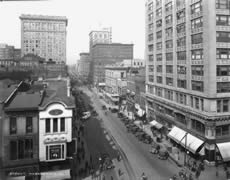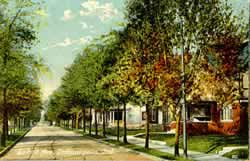Janet Flanner was born on March
13, 1892, in Indianapolis.
Flanner received an excellent education at both the local
public school, which she attended until the sixth grade, and
the new private school in Indianapolis, Tudor Hall. In this
private school, Flanner developed her love of writing.
 |
| Pennsylvania Street looking
north from Washington Street, Indianapolis, Indiana. William
H. Ball Photo Company, 1920. |
After graduating high school, Flanner and her family
traveled abroad for a year before returning to Indiana. The traveling
sparked an interest in Flanner to explore the world outside of Indianapolis
because in 1912 she enrolled in the University of Chicago in Illinois.
Two years after graduating in 1914, Flanner returned to her roots
in Indianapolis where she took up a career as the first cinema critic
for the Indianapolis Star.
In 1917, one year after moving back to her hometown,
Flanner took a job in Pennsylvania at a girl’s reformatory
to explore the world outside Indianapolis. However, she did not
remain long in Pennsylvania before moving to a more liberal part
of the United States-- New York City.
In 1922, Flanner moved
to Paris, France, and began to focus more on her writing.
Though she was primarily a newspaper journalist, she did write
one novel, The Cubical City. This
work spoke about landmarks and nature that are reflections
of her early life in Indiana.
The Cubical City takes place in New York City,
and is a love story based around the main character, Delia. There
are several references to the land Flanner once called home in Indianapolis.
She speaks about nature, the trees and the birds with a reminiscent
attitude. She discusses issues of deforestation
and urban sprawl
when she talks about the tragedy of trees being replaced by buildings,
and the bright seasons during the different times of the year. For
example, the novel states:
What had once been trees from open spaces were long
since turned to beams, gilded and carved before they had been
set up in her rooms and the only visible leaves and flowers were
those flattened by her feet on the garden of her rug. (18)
This statement shows that Flanner longed for the hometown
she left, the nature that surrounded her in Indianapolis. Even though
she found liberation in New York, she had to sacrifice the beauty
of the land to quench her curiosity.
As the novel continues, Flanner mentions a fictional
town, which she only refers to as a Middle Western town. Although
she never states the town is Indianapolis, her only midwestern
experience involved Indiana. There are references to this
town in more than one part of the novel, which may indicate
that she is writing about the midwestern town of her former
home in Indianapolis.
 |
Talbott
Avenue, Indianapolis. Copyright Indiana Penny Postcard Collection.
|
It was a middle western town that boasted of its
occasional wooded streets though in the outskirts where the
Pooles lived, a certain foresting was demanded even without
affection. (33)
One of Delia’s suitors, Paul, tries to convince
her that there are other places they may live happily. "There’d
be huge forests, speckled with orchids and hummingbirds. Beautiful
ones, Delia. And rice fields with Buffaloes
wading as we rode past" (78-79). By describing the beauty
of the land, Flanner relates to
the forests and lands she knew in Indiana.
Flanner continued to write
frequently after the publication of The Cubical City, but
it remained her only novel. She lived in Paris until 1975, when
she returned to New York City and remained there until her death
on November 7, 1978.
Flanner's writing connects to the land by suggesting
a longing for the peace of nature and the serenity of her
homeland. Although she remained away from Indiana most of
her life, she reminisced about the land she knew when she
grew up in Indianapolis.
--DSS
Sources:
Flanner, Janet. Darlinghissima.
Ed. Natalia Danesi Murray. New York: Random House Inc., 1985.
---. Janet Flanner’s
World. Ed. Irving Drutman. New York, New York: Harcourt
Brace Jovanovich, Inc. 1979.
---. The Cubical City. Southern
Illinois University Press, 1975.
Encyclopedia Britannica.
Sept. 2002. "Women in American History."
14 September 2002 <http://search.eb.com/women/articles/
Flanner_Janet.html>.
Rood, Karen L. “Janet Flanner.”
Dictionary of Literary Biography: American Writers in
Paris. Ed. Karen Lane Rood. Gale Research Co., 1980.
Vol. 4:151-61.
Vanausdall, Jeanette. Pride and
Protest: The Novel in Indiana. Indianapolis: Indiana
Historical Society, 1999.
Images:
Abbott, Bernice. "Janet Flanner."
Found in The Talk of the Town, Jane Grant, "The New
Yorker." Photograph courtesy of Commerce Graphics
Ltd., Inc. 7 November 2002. <http://libweb.uoregon.edu/speccoll/mss/JaneGrant/
human/janet.html>.Copyright © Bernice Abbott,
1927.
"Pennsylvania Street looking
north from Washington Street, Indianapolis, Indiana."
W. H. Bass Photo Company. Found in archives,
Indiana Historical Society. 14 November 2002. <http://157.91.92.2/cgiin/scandoc.cgi?app=1&folder
=725&doc=17>. Copyright © William H. Bass
Photo Comapany, 1920.
"Talbott Avenue, Indianapolis."
Archives, Indiana Penny Postcard Collection. 14 November
2002. <http://www.rootsweb.com/~usgenweb/in/marion/
postcards/talbott.jpg>. Copyright © Indiana Penny
Postcard Collection.
Links:
Women
in American History
|




